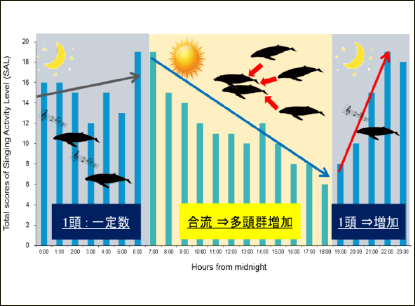- Home
- Okinawa Churashima Foundation Research Institute
- Studies of Marine Animals
- Research activity report
- The daily patterns in the singing activity of male humpback whales revealed!

Research on marine organisms
The daily patterns in the singing activity of male humpback whales revealed!
Male humpback whales produce complex sounds called songs. These songs are heard from the end of the feeding season and throughout the breeding season. Singing songs is thought to be related to breeding.
In the breeding grounds, males form competitive groups searching for females to mate with. These groups usually form just after sunrise, and they remain together during the day. In the afternoon and evening the groups reduce in size, and then break up.
Researchers from the Okinawa Churashima Foundation set up a fixed underwater microphone off the Motobu Peninsula in Okinawa Prefecture. The device recorded 24 hours a day, for 2 weeks during the breeding season. The recordings showed that whales sang more during the night than during the day. Observation surveys conducted from boats, indicated that males only sing when alone.
These results suggest that perhaps song activity is reduced during the day as male humpback whales are more likely to be in groups, and there are fewer males alone. However, male humpback whales may also be moving to different areas from day to night. To study this, researchers will place several fixed underwater microphones further offshore and continue with their research.
Authors
Nozomi Kobayashi, Haruna Okabe, Naoto Higashi, Hirokazu Miyahara H, Senzo Uchida.(Bold letters: the Churashima Foundation Staff)
Title
Diel patterns in singing activity of humpback whales in a winter breeding area in Okinawan (Ryukyuan) waters
Journal
Marine Mammal Science
Journal link
DOI: 10.1111/mms.12790
Underwater microphones installed off the Motobu Peninsula, Okinawa Prefecture (left), and a chart showing daily patterns in whale singing activity (right).
Horizontal numbers indicate the time of day (00:00 to 23:00). Vertical numbers indicate level of singing activity.
Copyright (c) 2015 Okinawa Churashima Foundation. All right reserved.






























